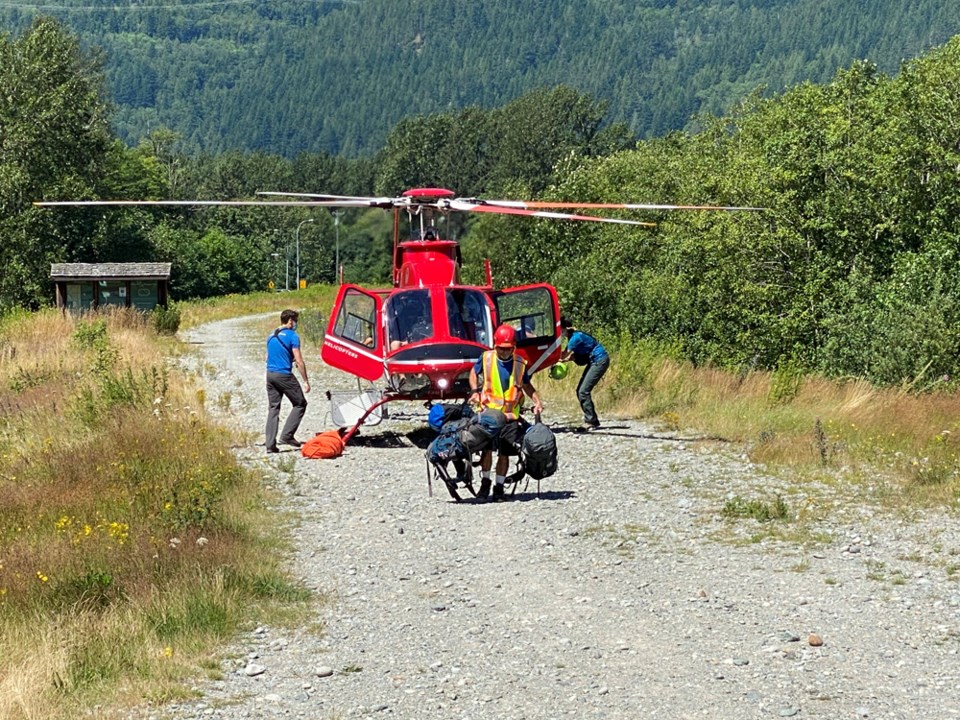Gorgeous weather over the last few days has meant a busier time for Squamish Search and Rescue, which fielded four calls over the weekend and three the days before.
Rescue manager Tyler Duncan said that on Saturday crews responded to a hiker with a broken arm at Watersprite Lake.
The hiker tripped and fell, and couldn't walk out with the injury. As a result, crew flew in and took the person back to safety.
Duncan said it was a relatively straightforward rescue.
"That was fairly easy — sort of fly in, fly out," he said. "Which is always nice when it works out like that."
Later that day, crews would come to the aid of climbers in the Tantalus range.
A climber slipped and fell into a bergschrund crevasse, which is formed where the snow and rock meet, Duncan said.
"It was essentially a full crevasse rescue," he said.
The climber hit his head badly, but appeared to be coherent and talking. Crews had to raise him out of the crevasse and fly him to the hospital.
Late Saturday night, Lions Bay Search and Rescue called Squamish Search and Rescue to help with another operation.
Two people found themselves stuck on the West Lion.
"They were on some very technical sort of thin ridge terrain on the near the peak of the West Lion so Lions Bay asked for some help from a rope rescue and a helicopter rescue," said Duncan.
Squamish rescuers helped out with rope access, while North Shore Rescue assisted with the helicopter.
Late Sunday night, crews were once again called to the Tantalus for an injured person.
"One of them twisted their ankle crossing a bit of a scree slope and...they were in some pretty technical terrain so they weren't comfortable limping out on a twisted ankle," said Duncan.
They dug out a landing pad in the snow, and rescuers picked them up and flew them out of the glacier on Monday morning.
"It was a nice straightforward one as well," Duncan said.
He said it's important people stay prepared for a possible lengthy rescue and that they play within their limits.
Before the weekend hit, crews were already busy, responding to three calls on July 14 and 15.
Crews received three calls over that couple of days, with one incident requiring an hour-long rope rescue of a climber that went into the early morning.
The call for the climber came in on the evening of July 15.
Rescue manager BJ Chute said a climber broke his arm on Slhanay on the Birds of Prey route.
Chute said that a large rock fell, and in the process, the climber was injured.
The climber appeared to have pulled out a loose hold. Chute said he was unclear whether the climber was injured by taking a fall or by falling rock.
In the process, the rope also appeared to be damaged.
Chute said rescuers brought in the SAR rope rescue team, which raised the climber to top of Slhanay. They walked the injured man down the monolith.
Crews brought out his partner as well.
The climbers were from Squamish, Chute said.
About 20 volunteers were called in to help make the rescue happen. The rescue wrapped up at around 2 a.m.
That same day, a few hours beforehand, crews came to help a lost hiker at Yuko's Pond, which is just off Al's Habrich Trail above the Sea to Sky Gondola.
"He wasn't prepared to be out for very long, and he lost his eyeglasses, so when he couldn't find his way out and recognized he needed assistance, he called 911," said Chute.
Crews flew a team in, and along with Sea to Sky Gondola staff, found the hiker and flew back to Squamish.
Again, about 20 SAR volunteers were called in to assist.
Chute said that it's a good reminder for people to be prepared with enough gear to stay the night, because if the climber fall happened a little earlier, resources would've been diverted to the more serious incident. It could mean rescuers could take significantly longer to respond to calls.
On July 14, rescuers were called to help with what appeared to be a paraglider tangled up on the Stawamus Chief.
However, it turned out to be a false alarm — it was in fact locals putting on an aerial silks photography shoot.
Chute said it would be best for people to let authorities know about these types of events beforehand so it doesn't create another false alarm.




